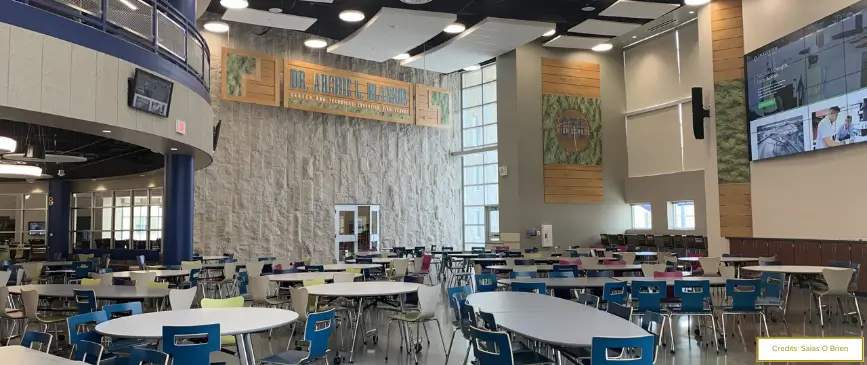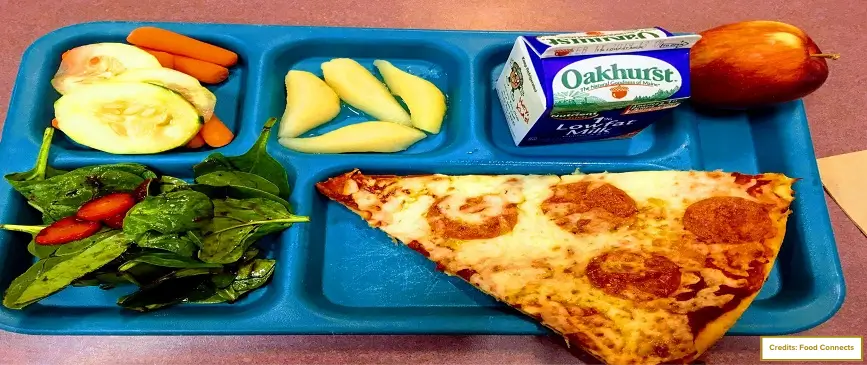Introduction
For many families across the United States, school lunches are a daily necessity to ensure that students receive a nutritious and balanced meal during their school day. But have you ever wondered how these lunches are made possible and what goes on behind the scenes in your school cafeteria? That’s where the National School Lunch Program (NSLP) comes into play.
In this article, we’ll take a closer look at the NSLP, explain what it means for your school cafeteria, and explore the advantages and disadvantages of this federal initiative. Whether you’re a concerned parent, a curious student, or an educator interested in the ins and outs of school nutrition, this article will shed light on the vital role the NSLP plays in the daily lives of millions of students.
So, without further ado, let’s get started.
Article At A Glance
- Objective and Scope: The NSLP is a federal initiative, started in 1946, aimed at providing nutritious meals to students, especially those from low-income families. It operates in public and nonprofit private schools across the U.S., under the administration of the USDA.
- Benefits of NSLP: The program significantly reduces hunger among school children, enhances their academic performance by providing the necessary nutrition, and promotes healthier eating habits by setting standards for school meals.
- Challenges Faced: Despite its advantages, the NSLP faces issues such as perceived low food quality and taste, administrative burdens on schools due to paperwork and regulations, and budget constraints that may affect the program’s ability to cover the costs of healthy meals fully.
- Participation Requirements: Schools participating in the NSLP must adhere to various requirements, such as determining student eligibility based on income, following USDA nutritional standards, ensuring food safety, complying with non-discrimination policies, accurately documenting meals for reimbursement, and promoting nutrition education.
What is the National School Lunch Program?
The NSLP is a federal initiative that ensures students have access to nutritious meals during the school day. Established in 1946, the program is administered by the United States Department of Agriculture (USDA) and operates in both public and nonprofit private schools.
The primary objectives of the NSLP are threefold. Firstly, it guarantees that students receive nutritious meals, contributing to their overall health and well-being. Secondly, the program strives to alleviate hunger and food insecurity among school-aged children, with a particular focus on those from low-income households. Lastly, NSLP supports the learning process by providing students with the essential nutrition to concentrate and excel academically.
Suggested Reading: Why is Nutritional Education Important for Schools?
Pros and Cons of the National School Lunch Program
This program has been a cornerstone of school nutrition for decades. While it brings numerous benefits, it also presents its own set of challenges. Therefore, we would like to bring you the positives and negatives of the NSLP to shed light on how it impacts students, schools, and the broader community. By examining the program from both angles, we can understand its importance in our educational system.
| Pros of NSLP | Cons of NSLP |
| 1. Reduced Hunger among Students
|
1. Perceived Low Food Quality and Taste
|
| 2. Improved Academic Performance
|
2. Administrative Burden on Schools
|
| 3. Promotion of Healthier Eating Habits
|
3. Budget Constraints
|
So, let’s begin with the pros first.
Pros
Reduced Hunger
This program helps lessen hunger and worries about insufficient food among school kids. It guarantees that students enjoy a balanced meal every school day. This meal is a lifeline for many children, helping them fight off hunger and stay focused on their studies. It’s like a safety net that ensures no child has to go through the school day with an empty stomach.
Academic Performance
When students have nutritious meals, they have the energy and focus they need to learn and excel in their studies. Think of it like fuel for their brains. Good food can significantly affect how well they understand lessons and solve problems. So, the NSLP isn’t just about food; it’s also about giving students the chance to succeed in their education. When well-fed, kids can concentrate better, leading to better grades and a brighter future.
Healthier Eating Habits
The NSLP helps schools make sure students eat healthily. It does this by setting rules about what foods can be served in school lunches. These rules encourage schools to offer better choices like fruits and vegetables and less unhealthy stuff. It’s like having a guide for what’s good to eat.
Plus, the program helps schools teach students about making smart food choices so they know what’s good for their bodies.
Suggested Reading: Are School Lunches Healthy?
Cons
Food Quality and Taste
One challenge with the NSLP is that some people think the food isn’t as tasty or varied as they’d like. This can be a concern because when students don’t enjoy the food, they might not eat it, leading to food going to waste. Critics say that school meals should be more appealing to students’ taste buds and offer a wider variety of options. Students may not get all the program’s benefits when the food isn’t as delicious as hoped.
Suggested Reading: 5 Ways to Reduce Food Waste in Schools
Administrative Burden
Another challenge is that schools must deal with a lot of paperwork and rules to participate in the program. This can be time-consuming and use up valuable resources. Schools need to keep records, handle applications, and follow many regulations. Some people find these administrative tasks quite burdensome. It requires a lot of extra work, which can be challenging for schools, especially smaller ones with limited staff and budgets.
Budget Constraints
One issue with the NSLP is that its money may not always be enough to cover all the costs of serving healthy meals. This means that some schools might face budget problems. They could use money from other parts of their budget to make the difference. So, while the NSLP helps, it might not cover everything. Schools must figure out how to balance their budgets to keep offering students nutritious meals and other essential services.
Requirements for Schools to Participate in NSLP
To participate in the National School Lunch Program, schools must meet several essential requirements to ensure that eligible students receive nutritious meals and that program standards are upheld.
| Requirement | Description |
| Student Eligibility Determination
|
Identify students eligible for free or reduced-price meals based on income.
|
| Adherence to USDA Nutritional Standards
|
Follow specific types and quantities of food components in meals.
|
| Food Safety Maintenance
|
Ensure safe handling, storage, and preparation of food.
|
| Compliance with Non-Discrimination Policies
|
Provide meals without discrimination based on race, color, nationality, sex, age, or disability.
|
| Documentation for Reimbursement
|
Accurately document and submit claims for federal reimbursement.
|
| Promotion of Nutrition Education
|
Educate students about healthy food choices and nutritional content of meals.
|
Firstly, schools must determine which students are eligible for free or reduced-price meals based on income guidelines. This process helps identify students from families with limited financial resources who require assistance obtaining balanced and affordable meals.
Secondly, schools must follow nutritional standards and meal patterns established by USDA. These standards suggest the types and quantities of food components that must be included in each meal. By adhering to these standards, schools ensure that their meals meet the dietary guidelines and contribute to students’ health and well-being.
Maintaining food safety is another crucial requirement. Schools must handle, store, and prepare food in a manner that ensures it is safe for consumption. This helps prevent foodborne illnesses and promotes the overall health of students.
Furthermore, participating schools must follow the non-discrimination policies to ensure that they provide meals to all eligible students without discrimination based on race, color, national origin, sex, age, or disability.
The NSLP offers federal cash reimbursements to schools for each eligible meal served. Therefore, schools must correctly document and submit claims to receive reimbursement. And lastly, schools are encouraged to promote nutrition education as part of the NSLP. This involves educating students about the importance of making healthy food choices and understanding the nutritional content of the meals they consume.
Conclusion
The NSLP has its advantages and disadvantages. On the positive side, it fights hunger, improves nutrition, and boosts academic performance for many students. But it’s not without its challenges, like food quality and budget constraints. The program’s requirements ensure eligible students get healthy meals, but schools must navigate administrative burdens.
Ultimately, balancing providing nutritious meals and overcoming program challenges is critical. By addressing its drawbacks and focusing on its strengths, the NSLP can continue to positively impact the well-being and education of students across the United States.




